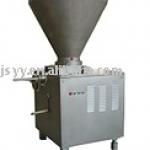latest hot-sale multifunctional bone gelatine machines 6
| Condition:New | Type:Other | Automatic Grade:Automatic | Place of Origin:China (Mainland) |
| perfomance:good | taste:good |

Gelatinis a translucent, colorless, brittle (when dry), flavorless solid substance, derived from collagen obtained from various animal by-products. It is commonly used as a gelling agent in food, pharmaceuticals, photography, and cosmetic manufacturing. Substances containing gelatin or functioning in a similar way are calledgelatinous. Gelatin is an irreversibly hydrolysed form of collagen, and is classified as a foodstuff. It is found in most gummy candies as well as other products such as marshmallows, gelatin dessert, and some ice cream, dip and yogurt. Household gelatin comes in the form of sheets, granules, or powder. Instant types can be added to the food as they are; others need to be soaked in water beforehand
Gelatin is a mixture of peptides and proteins produced by partial hydrolysis of collagen extracted from the skin, boiled crushed horn, hoof and bones, connective tissues, organs and some intestines of animals such as domesticated cattle, chicken, pigs, and horses. The natural molecular bonds between individual collagen strands are broken down into a form that rearranges more easily. Gelatin melts to a liquid when heated and solidifies when cooled again. Together with water, it forms a semi-solid colloid gel. Gelatin forms a solution of high viscosity in water, which sets to a gel on cooling, and its chemical composition is, in many respects, closely similar to that of its parent collagen. Gelatin is also soluble in most polar solvents.
The main processing is as below
1Pretreatment
2Extraction
After preparation of the raw cool material, i.e., reducing crosslinkages between collagen components and removing some of the impurities such as fat and salts, partially purified collagen is converted into gelatin by extraction with either water or acid solutions at appropriate temperatures. All industrial processes are based on neutral or acid pH values because though alkali treatments speed up conversion, they also promote degradation processes. Acid extract conditions are extensively used in the industry but the degree of acid varies with different processes. This extraction step is a multi stage process, and the extraction temperature is usually increased in later extraction steps. This procedure ensures the minimum thermal degradation of the extracted gelatin.
This process includes several steps such as filtration, evaporation, drying, grinding, and sifting. These operations are concentration-dependent and also dependent on the particular gelatin used. Gelatin degradation should be avoided and minimized, therefore the lowest temperature possible is used for the recovery process. Most recoveries are rapid, with all of the processes being done in several stages to avoid extensive deterioration of the peptide structure. A deteriorated peptide structure would result in a low gelling strength, which is not generally desired.
3Drying for the powde
Uses
Probably best known as a gelling agent in cooking, different types and grades of gelatin are used in a wide range of food and non-food products: Common examples of foods that contain gelatin are gelatin desserts, trifles, aspic, marshmallows, candy corn, and confections such as Peeps, gummy bears and jelly babies. Gelatin may be used as a stabilizer, thickener, or texturizer in foods such as yogurt, cream cheese, and margarine; it is used, as well, in fat-reduced foods to simulate the mouthfeel of fat and to create volume without adding calories.
Gelatin is used for the clarification of juices, such as apple juice, and of vinegar. Isinglass, from the swim bladders of fish, is still used as a fining agent for wine and beer. Beside hartshorn jelly, from deer antlers (hence the name "hartshorn"), isinglass was one of the oldest sources of gelatin.

| Packaging Detail:wooden box |
| Delivery Detail:ASAP |














